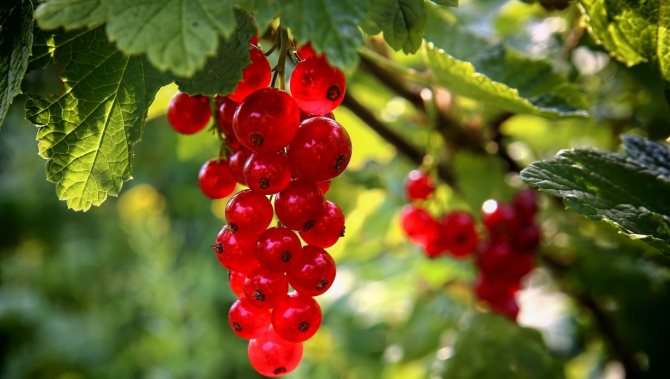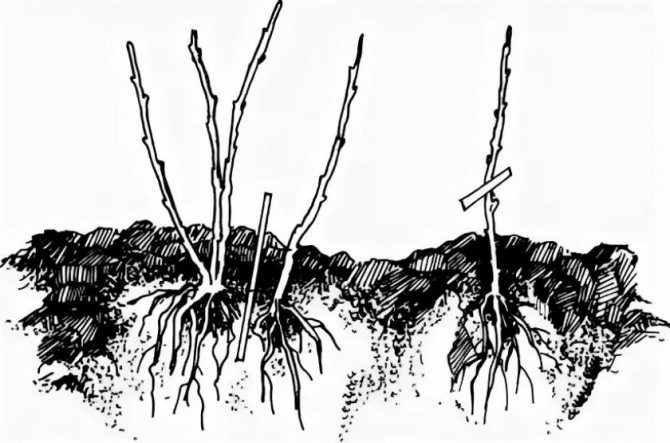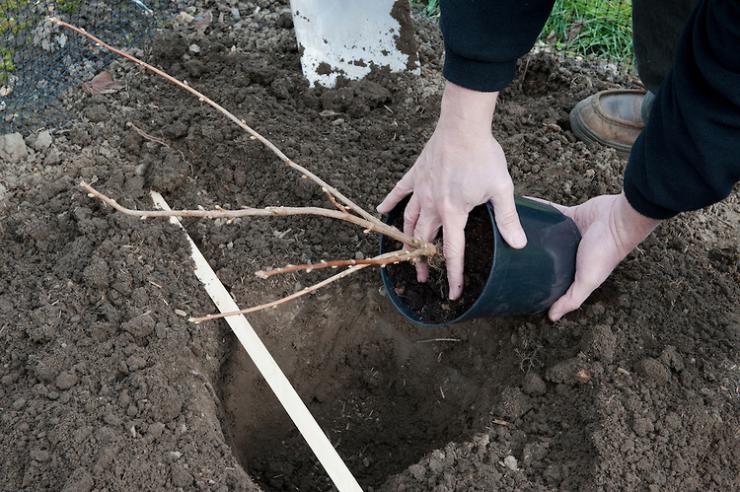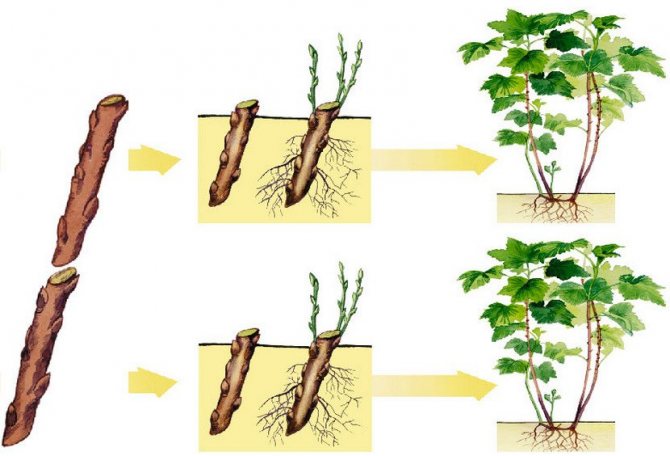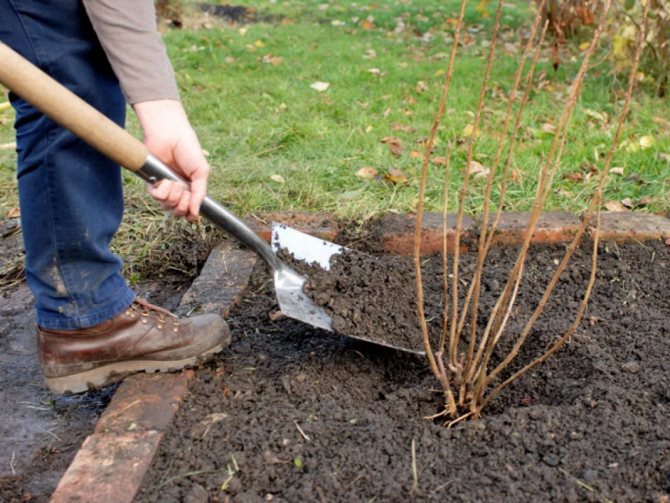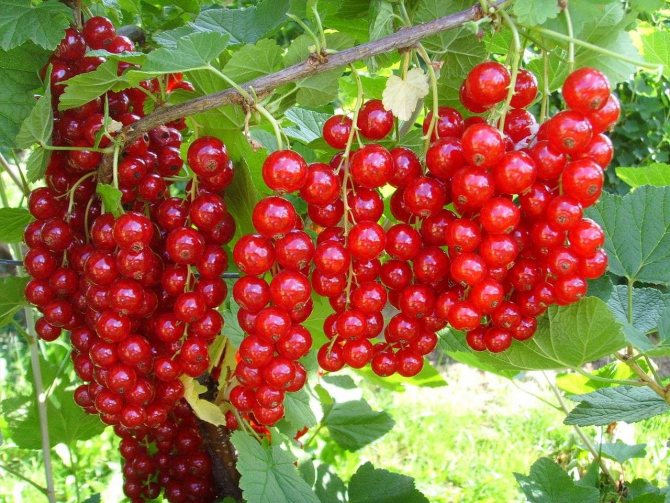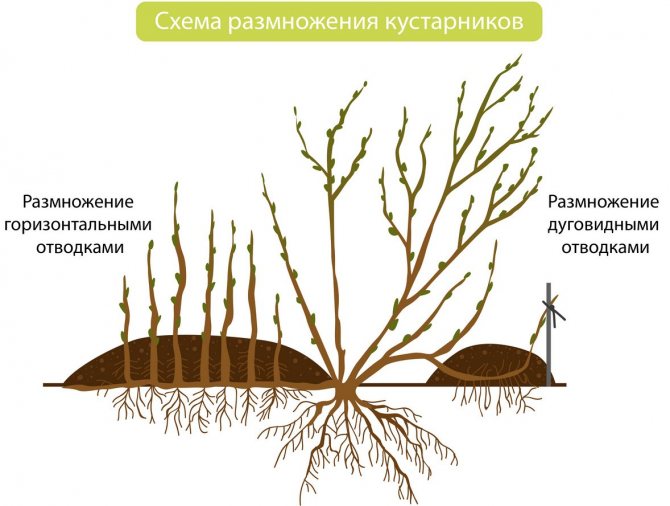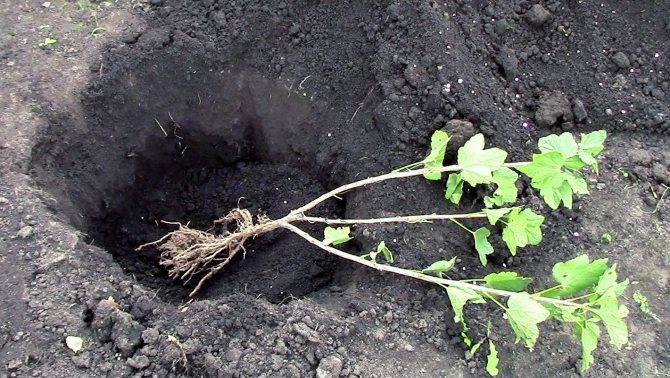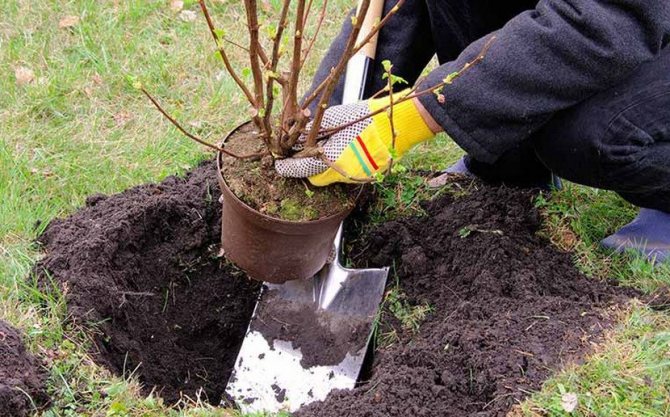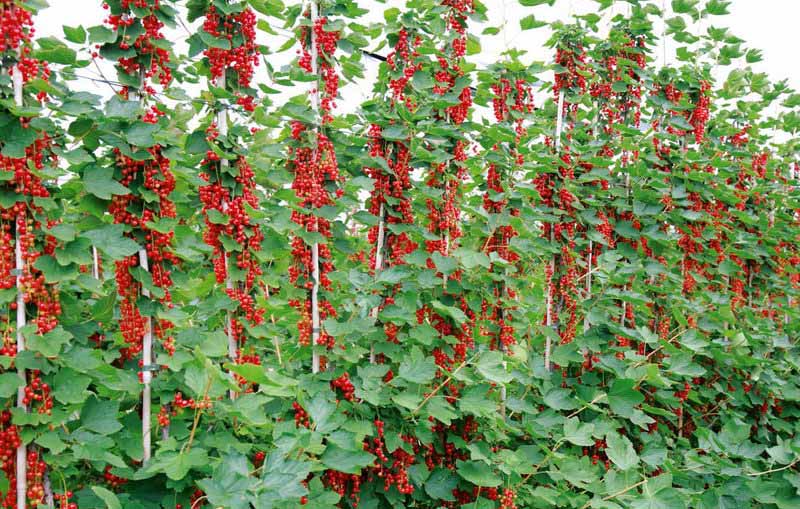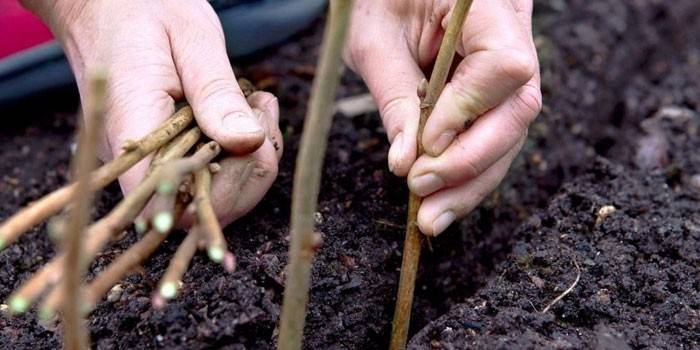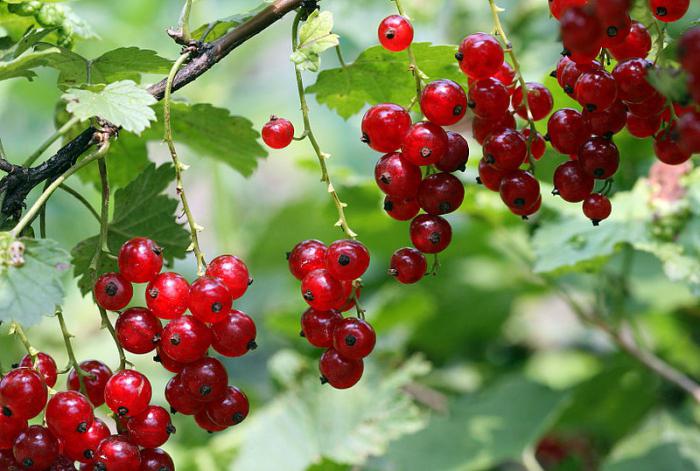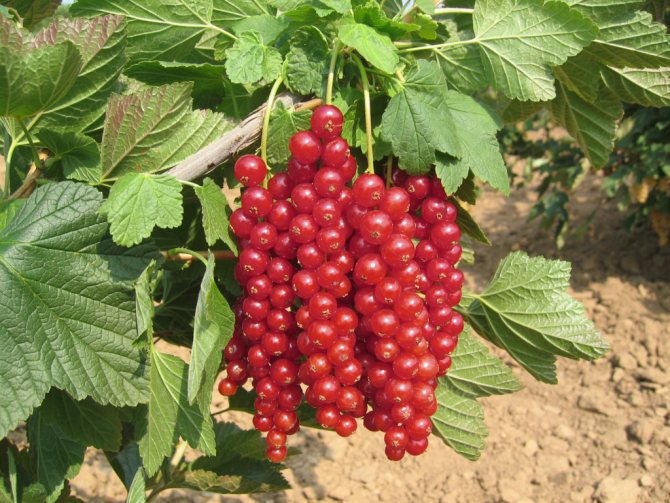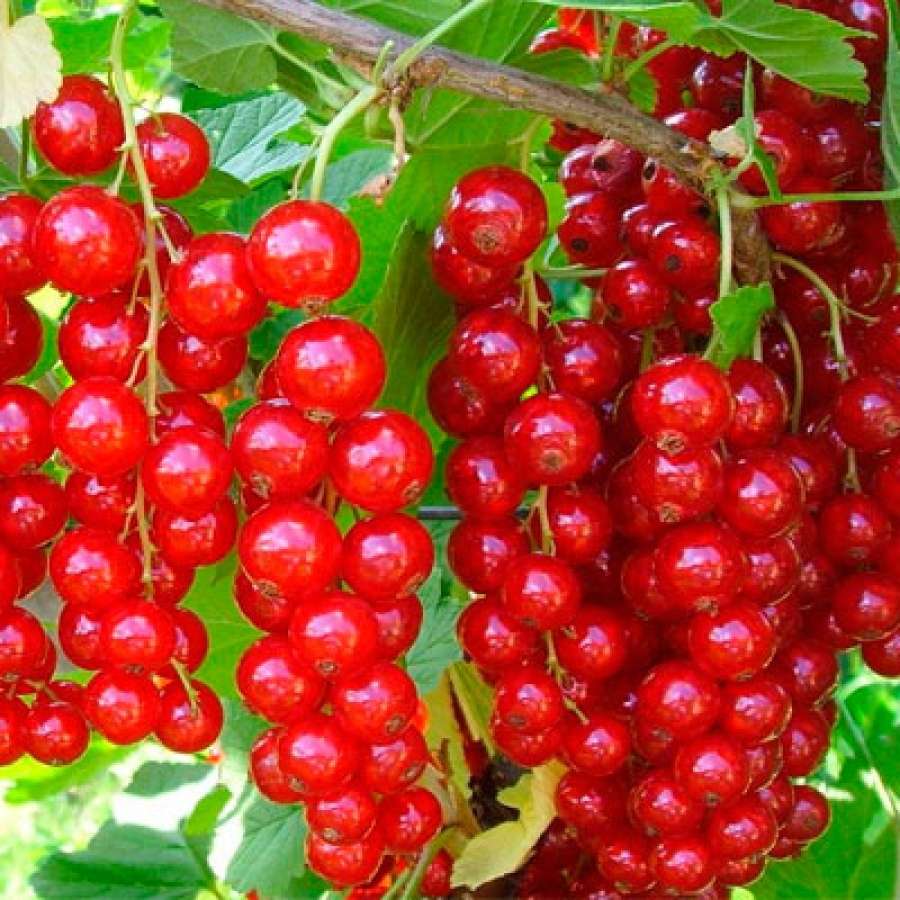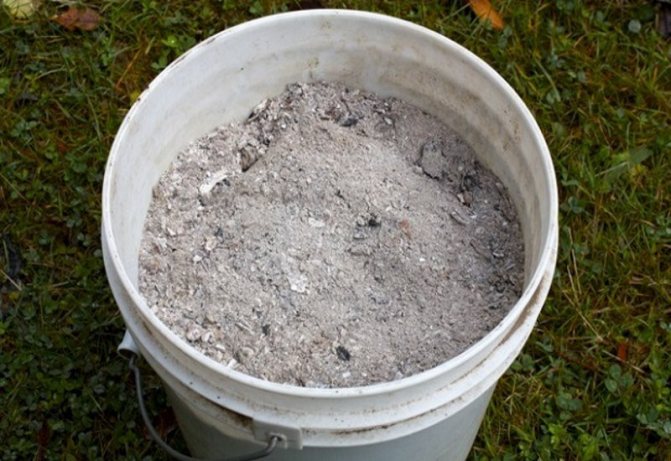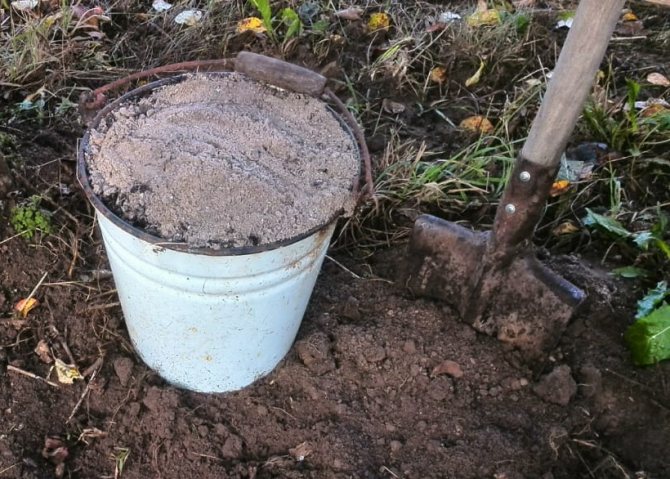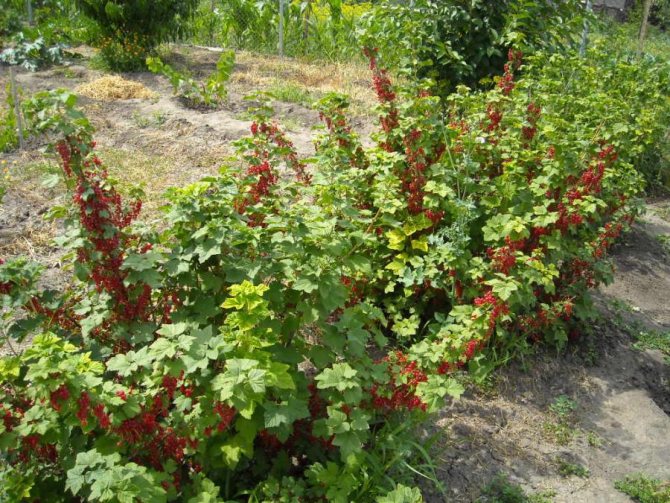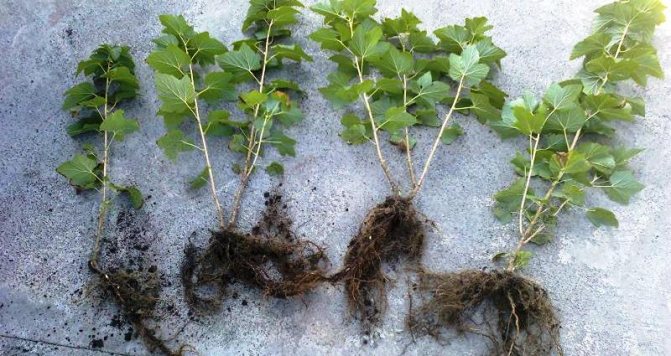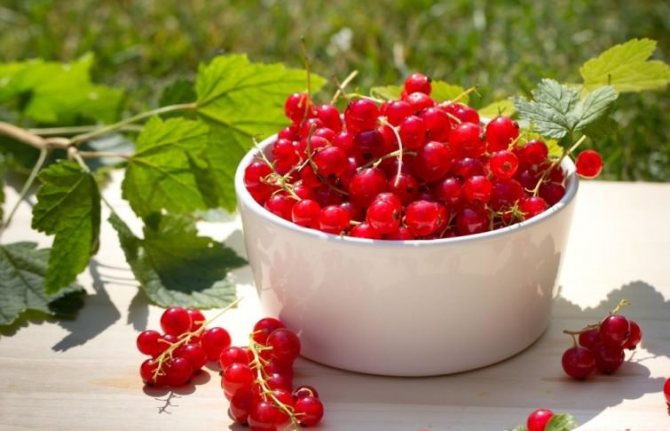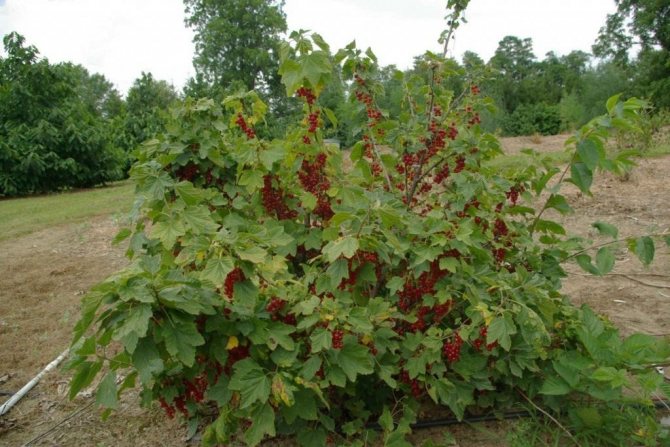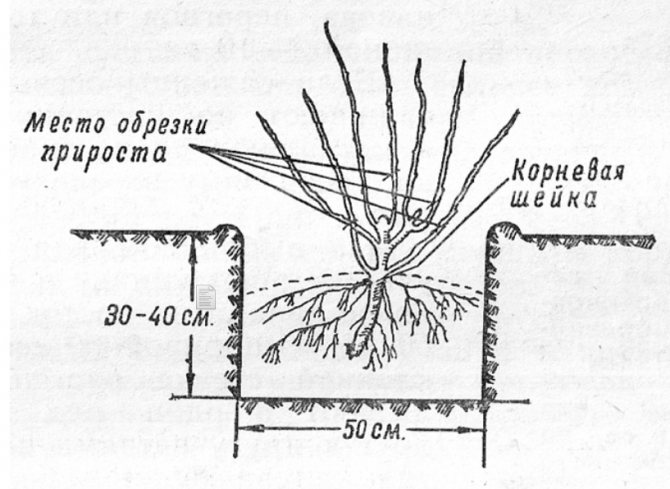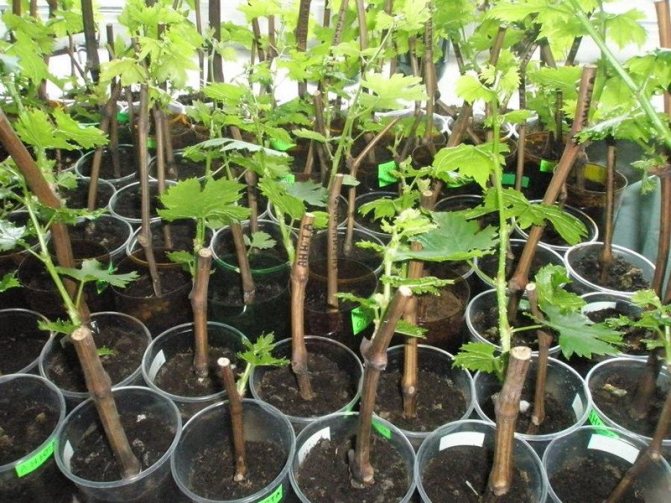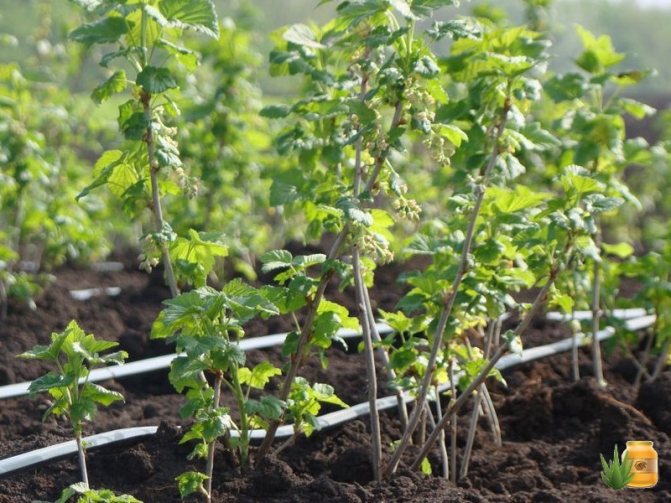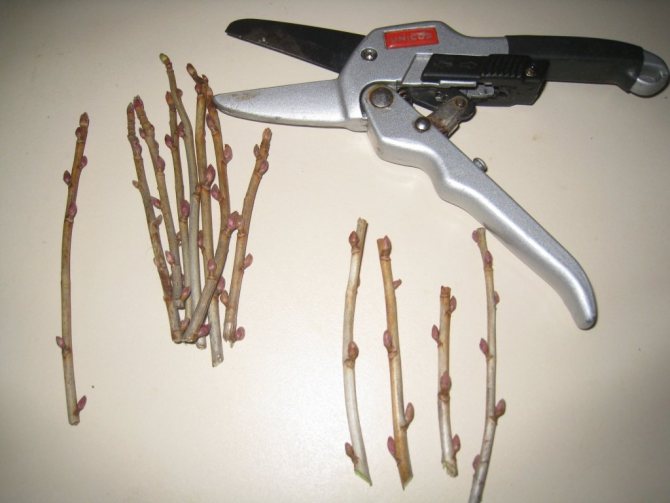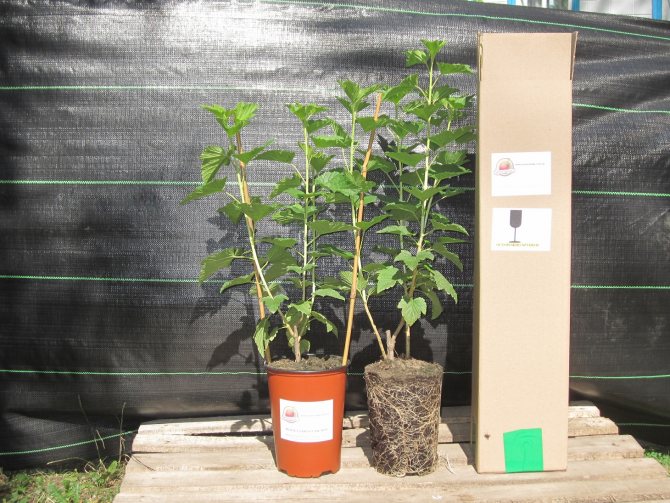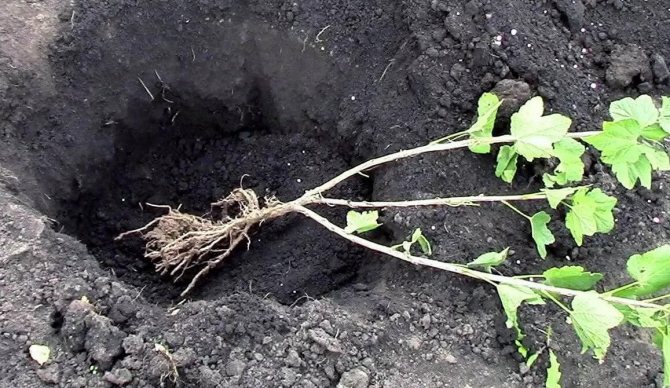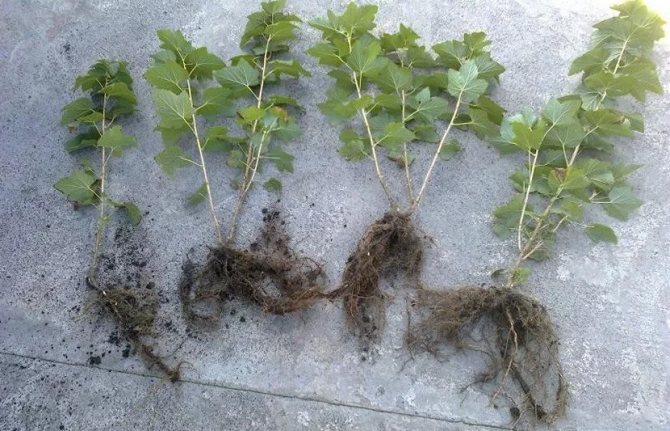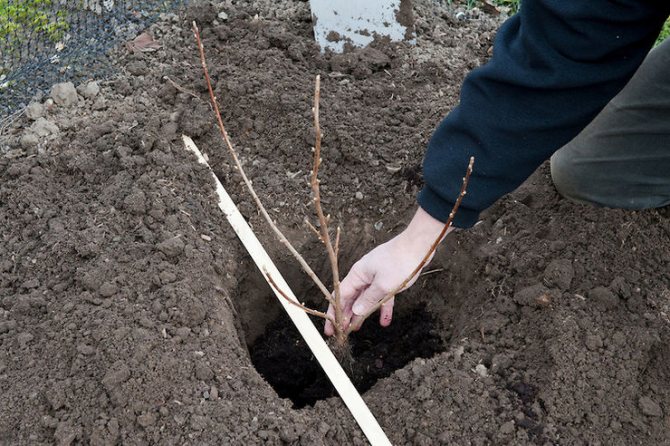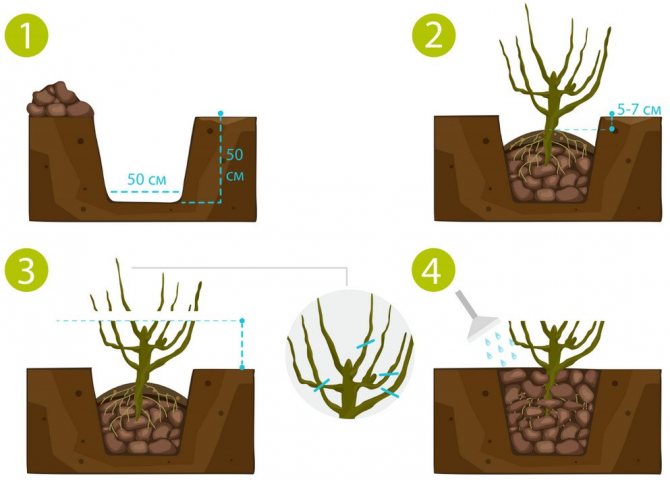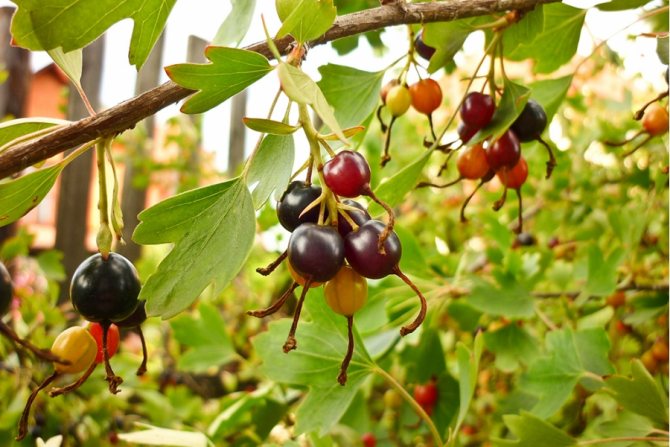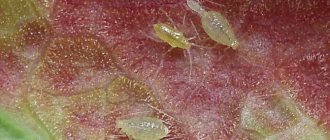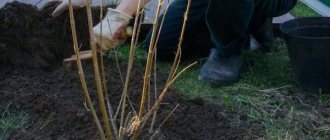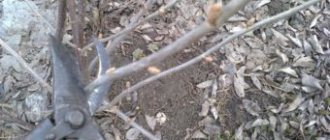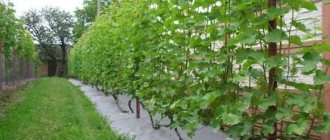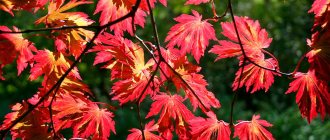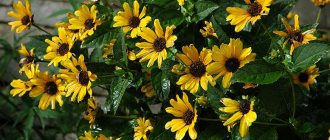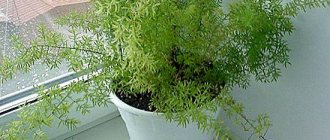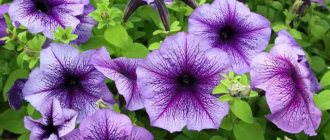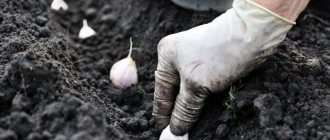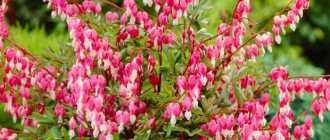Red currants are not as spreading as black ones: their shoots tend upward, and not in breadth, which means that this culture takes up less space in the garden. The plant needs more light, but it does not require moisture. Red currants can grow in one place for a long time (up to 25 years) without losing yield. These features must be taken into account when choosing a place for a seedling and planting it.
- 1.1 Planting in spring
- 1.2 Landing in summer
1.2.1 Video: the pros and cons of seedlings in a container
- 2 Choosing a place for a seedling, bad and good neighbors
- 3 Preparing the pit
3.1 Video: how to properly prepare a landing pit
- 4.1 Video: rules for planting a currant bush
The best varieties of black currant for the Urals
In the spring, a huge assortment of black currant seedlings is presented on the markets. Small-fruited and large-fruited varieties are on sale. They are divided according to the ripening period - early, middle and late. To get a good harvest of berries in the Ural climate, they give preference to varieties of local breeders.
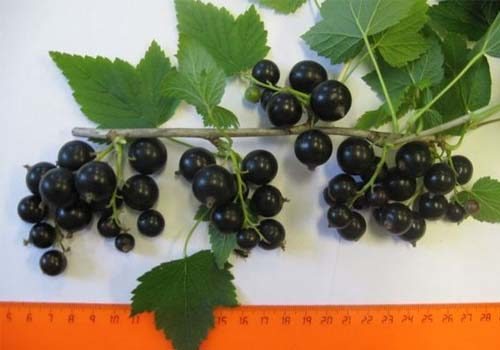
Good Genie
Good Genie - a variety of black currant, early ripening. Bred by breeders of the Sverdlovsk CCC by crossing the Dikovinka and Fertodi varieties. Spreading bush, medium height. Long brushes with berries are formed on the branches. The average weight of the berries is 1.3 grams. The fixed maximum weight is 6 grams. Very tasty. Berries are used for freezing, fresh consumption and processing. Advantages - high self-fertility, winter hardiness. Resistant to kidney mites and powdery mildew.
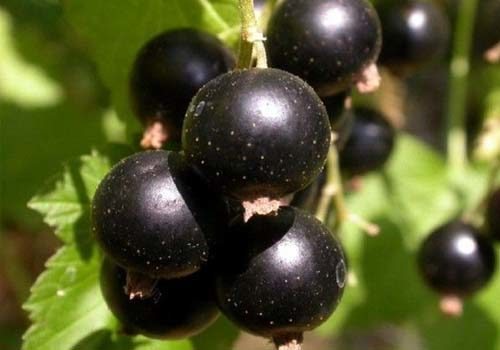

Chant Ural
Chant Ural - received at GNU SSSS. Variety of early flowering and late yield. Refers to late ripening. Semi-spreading, vigorous bush. Quite large berries ripen, with a maximum weight of up to 5 grams. Berries with a delicate skin, sweet and sour taste. High resistance to kidney mites and powdery growth is noted.
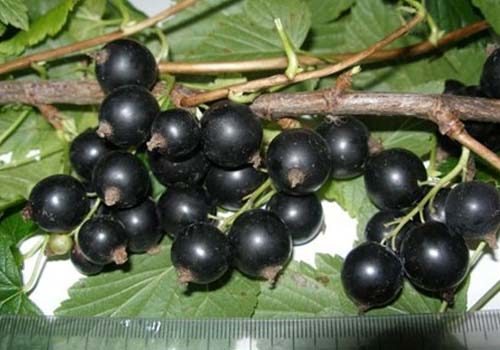

Currant Globe. Photo
the globe - a variety of medium ripening currants. Obtained by crossing the varieties Minai Shmyrev and Leningrad Giant. The flowering period on the bushes is average. A medium-sized bush with large leaves. Refers to large-fruited varieties - berries up to 6 grams. Nice dessert taste. After ripening, the berries are easily plucked to the bush. Due to dry separation, currants are suitable for fresh transportation and storage. The Globus variety is distinguished by its high resistance to kidney mites and powdery mildew. A bush with high winter hardiness, tolerates frosty winters without problems.
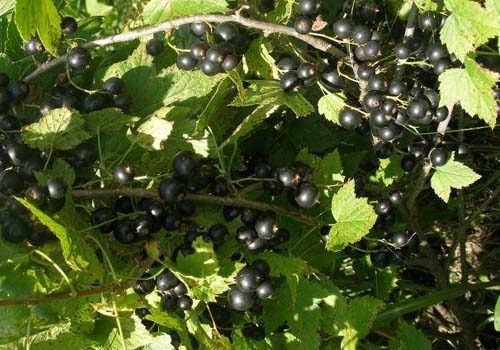

Gross Currant
Gross - one of the well-known varieties of black currant, obtained at GNU VSTISP. Well accustomed to the conditions of the Urals. The berries ripen late, the yielding period is extended. Fruits are irregular, ranging in size from one gram to six. The peel of the berries is tender, the flesh tastes sweet and sour. High self-fertility and frost resistance are noted. Another plus is that it is not affected by kidney mites and powdery mildew for a long time.
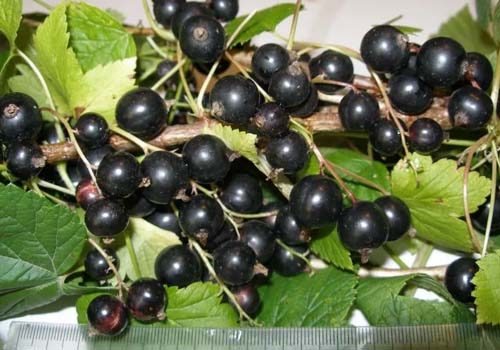

Popular variety Slavyanka
Slav - a variety of late flowering. Due to this, flowers are rarely damaged by spring frosts. Medium ripening blackcurrant variety.Berries are round in shape, black in color, with a maximum weight of up to 3 grams. Nice dessert taste. The bush is medium-sized, slightly spreading. Pros - high resistance to powdery mildew. High self-fertility and winter hardiness are noted. Of the minuses - low resistance to kidney mites.
You might also like: Pygmy, Prospector, Pennant, Musketeer, Atlas, Ataman, Cavalier, Quiz, Pilot, Fortune and Voivode... These varieties are presented in the Sverdlovsk breeding station. This means that they are best suited for the Ural climate.
Read the article on planting gooseberries outdoors in spring.
conclusions
- Preparatory work for the spring planting of varieties Bagheera, Sokrovische and others should be started in the fall or 1-1.5 months before planting.
- When choosing a seedling, it is necessary to assess its root system, the absence of leaves and the state of the buds.
- Planting times vary from region to region and depend on the temperature of the air and soil warming up.
- When planting, it is important to observe all basic agrotechnical rules, otherwise the plant may not take root.
- The most intensive watering is done after planting the seedling until it takes root and the first leaves appear.
Is it possible to plant black currants in spring
Any experienced gardener will tell you that the best time to plant currant seedlings is autumn. But if at the end of summer they did not have time to plant, then do not despair. Plants take root well in spring.
The main advantage of the spring planting of black currants is that the plants have time to fully take root and immediately grow. During the summer-autumn season, a huge number of branches grow, on which berries appear in a year.
An important disadvantage is that it is difficult to guess with the date of planting of seedlings. If it's too early, plants can freeze in cold ground. At a later date, when the buds swell and sap flow begins, the currant does not take root well. The main thing is to find the "golden" mean.
Currant seedling planting process
Despite the apparent simplicity, planting young currants has its own characteristics. If you know and use them, the seedling will take root very easily, grow and quickly give new shoots necessary for the formation of a bush.
So, we plant red currants:
- In a prepared and filled planting hole, make a hole slightly larger than the root of the seedling.
- Place the seedling at a 45⁰ angle with the tip pointing north. In this position, young shoots will grow from the south side, without shading the old ones.
- Deepen the seedling, that is, place it in the hole so that part of it (5–7 cm from the root collar) is underground.
- Cover the roots with soil, lightly tamp.
- Make a roller around the circumference, pour the currants and mulch.
Video: rules for planting a currant bush
There is an opinion: if you shorten (trim) the roots of the seedling, then the root buds will wake up faster, from which the replacement shoots will grow. But such operations are on the shoulder only for experienced gardeners, it is better for beginners to skip this step in planting currants.
When to plant black currants in spring
In what month should the seedlings be planted? It is recommended to start planting after the snow has melted. You need to finish gardening before budding. Saplings with blossoming leaves take a long time to take root in a new place and get sick for a long time.
Every year, spring frosts go off at different times. Therefore, they choose the time of rooting of seedlings according to the weather. Landing is tentatively performed in May, when the temperature is set to +10 degrees during the day, and at least +5 at nights. This rule is more suitable for the Urals, in Siberia the heat comes a little later.
If the currants are planted too early and according to the weather forecast severe frosts are expected in the coming days, it is recommended to cover the plants overnight. Agrofibre is used as a shelter.
Red currant composition
For the healing properties of red currant, it was appreciated as early as the 16th century and was considered a natural source of health. So modern alternative medicine uses these qualities of the berry to this day. It contains up to 4% acids and up to 10% sugar, mineral salts, pectin and tannins, carotene, iodine, vitamins such as A, C, P, B1 and B2 important for health. And although red currants are significantly inferior to black ones in terms of vitamin C, nevertheless, there is no less of it than in raspberries and strawberries.
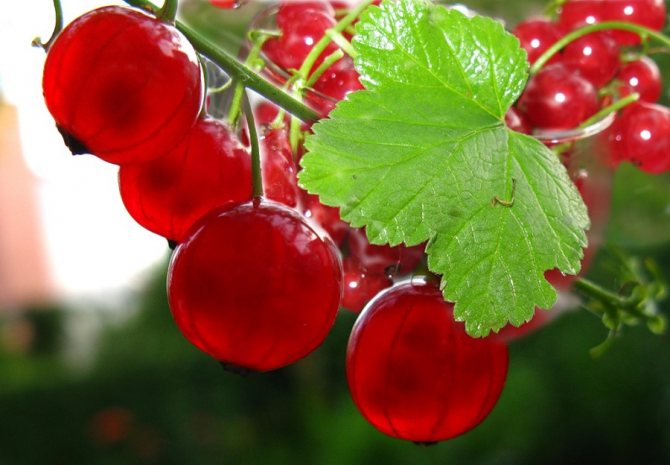

Red currants are rich in potassium, which has a positive effect on the work of the heart and helps to remove excess fluid from the body, as well as iron, which is very necessary for blood vessels. This berry contains coumarins and furocoumarins, which have analgesic and anticancer effects. In addition, coumarin treats increased blood clotting. Compared to black currants, red currants have a higher content of vitamins P and A.
Choosing a landing site


Where the bushes will be located on the site, the gardener must think over in advance. When choosing a place, take into account the preferences of the berry culture. Like all plants, currants love sunlight, moderate humidity and, of course, nutritious soil.
Soil type
Currant bushes develop well in breathable, non-acidic soil with a high humus content. Poor soils enrich with humus or compost. There is another option for enriching the soil with nutrients - adding forest land.
What to do if the soil is clayey in the garden. Increases aeration of river sand. A small amount is added for digging.
On acidic soil, currants develop poorly and give a small harvest. When planting, it is imperative that substances are introduced into the hole that lower the acidity level. These include (add optional):
- Dolomite flour
- Slaked lime in water
- Wood ash
- Ground chalk
Currants like moderate humidity. Cannot be planted in lowlands, where there is excessive moisture and at high elevations. Prefers flat or small slope culture.
Lighting
The presence of sunlight is one of the main criteria for choosing a landing site. In the shade, not only the yield on the bushes decreases, but the likelihood of infection with fungal diseases also increases. With a lack of light, currants will grow slowly and bush poorly.
Strong and cold wind negatively affects the development of plants. A high fence or buildings protects well from the winds. Even a small shadow from buildings is much better than a cold wind. Therefore, if there is a choice between an open sunny place with wind and a section along the fence, then the second option is preferred.
Characteristics and features of culture
The black currant shrub belongs to the genus Kryzhovnikovs and grows to a height of one and a half, or even two meters. Currant branches have light brown bark and leaves, which are placed alternately. They are palmate-lobed in shape, with three to five lobes. The upper surface of the leaf is dark green, the lower one is lighter, while it has a slight pubescence along each vein. In addition, there are also small yellow glands that secrete essential oil.
During flowering, the inflorescences are collected in small clusters. In this case, the flower has the shape of a wide bell. Ripe fruits are in the shape of a ball, no more than one centimeter in diameter. The color of the berries is from dark purple to black. You can recognize a currant bush by its pleasant smell, which is emitted not only by the berries, but also by the leaves.
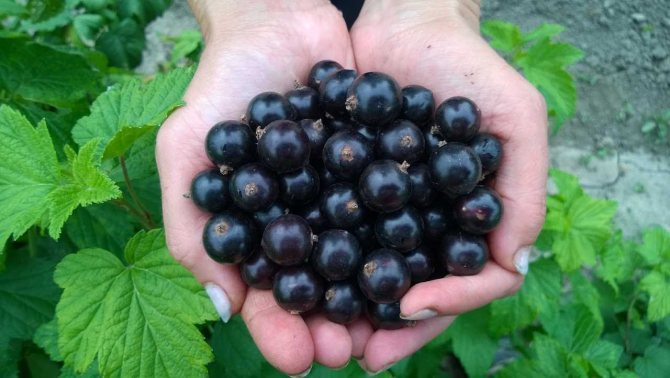

Black currant is a storehouse of useful elements
Flowering begins in late May and ends in early June. At the same time, the last frost can significantly damage the flowers. This reduces the yield of the plant. You can harvest currant fruits already in July and until August.
Black currant in most cases grows in the forests and forest-steppe zone of Russia, the middle zone of the Urals and Siberia. Likes to settle in places with sufficient moisture. These can be the banks of rivers or lakes. Prefers shady terrain or the outskirts of swamps.
It reproduces in several ways:
- root shoots;
- using bent branches;
- dividing the bush.
Today, black currant is one of the most popular shrubs, both in an industrial garden and in an individual. Most of all it is grown in France, where excellent drinks are made from its fruits. In addition, currant berries are grown by the British and Germans.
It is best to plant currants in the fall, since during the winter period the earth will settle, and the root system develops more actively in the spring. But you can plant currant seedlings in the spring.
Selection and preparation of a seedling
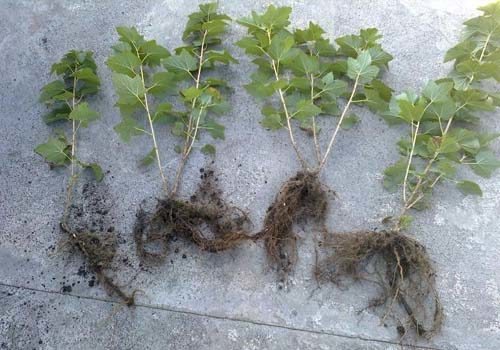

Late planting, so the leaves have blossomed
The seedlings contain the quantity and quality of the future harvest. Therefore, it is important to pay attention to the choice of planting material. A healthy seedling is distinguished by its appearance:
- The roots are not overdried, but alive;
- Strong root system with 2-3 main rods, at least 25 cm long;
- The branches are even, without visible defects and mechanical damage;
- The bark is stiff at the base, and the upper part is smooth, not wrinkled.
Good to know. If there is a suspicion that the seedling is not alive, a small test is performed. To do this, gently pinch off the bark with a marigold: the brown color is a signal that the bush is dry or frozen. A green shoot under the bark indicates that the seedling is healthy.
The planting material does not need special preparation. Only cut off the damaged roots and shoots with a pruner. In currants with a closed root system (in containers), it is impossible to destroy the earthen lump. It is enough to cut off damaged shoots to healthy ones.
Common mistakes when landing
It is possible to ensure the survival of currants, not only by observing all agrotechnical techniques, but also by choosing the right planting time. Late planting will not allow the plant to take root, and too early will not protect it from unexpected frosts and cold soil.
Planting time also depends on the region of cultivation. So in Siberia, it can even fall on May. Indeed, it is in this month that the average temperature there reaches the required + 8 ° С + 10 ° С. And in the southern regions, planting work can be carried out already at the beginning of March. Find out about the parthenocarpic cucumber variety here.
A seedling cannot take root if the planting hole is not deep enough. Poor, poorly fertilized soil will also interfere with its adaptation. Failure to comply with the preparation rules will lead to an increase in the survival time and possible infection of the seedling.
The chosen planting material is also of great importance. For beginners, it is best to make a purchase with experienced gardeners or in specialized garden nurseries that give a guarantee for their products.
Landing pit
A place for planting currant seedlings, prepared in the fall. This is necessary so that all fertilizers are absorbed into the soil and the earth shrinks a little. For black currants, a hole 40 cm deep and 60 cm wide is enough. In a depression of this size, the long rhizomes will be straightened out.
Soil from the pit (1/3 part), mixed with fertilizers: 300 g of wood ash, 1 bucket of compost and 200 g of superphosphate. The nutrient mixture is poured into the pit. Sprinkle with soil on top. Leave until spring.
What to do if there is clay on the site? You can replace the soil from the hole with fertile soil, or add a little river sand. In heavy soil, the crop does not develop well and produces few berries.
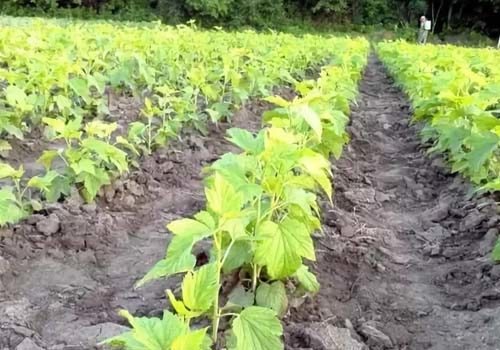

Dense rows method - used in the industrial cultivation of berries
At what distance should currant seedlings be planted? It all depends on the chosen landing method. Gardeners use the following:
- Dense rows - used in industrial cultivation. A distance of 0.5 meters is left between the bushes, and sometimes even less.
- In rows - one of the most popular methods for gardeners. A distance of 1 meter is maintained between bushes and rows. By the age of 5, the branches begin to close up and a continuous row is formed. To avoid thickening, anti-aging pruning is carried out.
- Single shrubs - leave at least 2 meters between the seedlings. This method is suitable for the preservation and propagation of a valuable variety. Due to the large distance between the bushes, there is a free area for rooting shoots.
Red currant care
Red currant is a rather unpretentious plant, however, to get a rich harvest of tasty and healthy berries, you should follow some rules and pay attention to seedlings. It is important to regularly prune red currants, watering and feeding. Also, the plant may periodically need help when signs of diseases or pests appear.
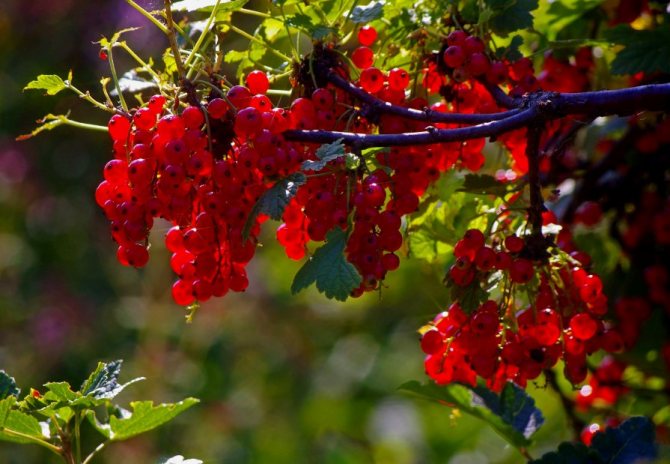

It is important to water the currant bushes in the spring and fall after harvest. At the same time, make sure not to overmoisten the soil, since this culture does not tolerate waterlogging. During the summer period, it is enough to water each currant bush 3 times. One bush usually takes about a couple of buckets of water so that the soil can be moistened by about 50 cm.
Immediately after the snow melts, the soil in the trunk circle must be well leveled and loosened to ensure the flow of oxygen to the roots. It is necessary to loosen approximately to a depth of 7-8 cm. Over the entire season, it may take about 3 loosening, which is most often carried out after watering. To avoid excessive evaporation of moisture, the soil in the trunk circle is mulched. For this, you can use peat or humus.
Since red currant is a very light-loving plant and when the bush thickens sharply loses its yield, its bush is formed from no more than 15-20 branches within 5-6 years, and from the seventh year, in addition to sanitary pruning, which involves the removal of unnecessary, diseased, broken or dried branches, it will be necessary to carry out a rejuvenating one - to remove branches that have served their life and regulate the growth of zero shoots. Of the zero shoots, the most developed and well-located ones are left for renewal, that is, those that grow closer to the bush do not lie on the ground and do not intersect with other shoots. They are shortened by half the length to the outer kidney, directed upward, and the remaining growths are cut out.
How to plant black currants in spring
In order for the shrub to take root in a new place without problems and in the future to please with a large harvest, it is necessary to plant seedlings according to all the rules. Step-by-step instruction:
- Dig a hole larger than the root system;
- The seedling is placed in a hole at an angle of 45 degrees, deepening by 10 cm;
- Straighten the roots of currants with an open root system;
- The hole is covered with soil and lightly tamped;
- Water the blackcurrant seedling with water (1 bucket per bush);
- The topsoil is mulched with foliage or large old sawdust;
While filling the hole with soil, lightly shake the seedling. This will help to avoid the formation of voids between the roots and the ground.
Harvesting currants
If you have followed all the recommendations on how to care for red currants, you will certainly have a good harvest. Red and white currants are harvested in one step, when all the berries are ripe. Harvesting currants is done with brushes, then the twigs are carefully removed and sorted. The collected berries are stored in small baskets and containers to avoid deformation. The berries are not re-poured and stored in a cool place or in household refrigerators.
When the entire crop is harvested, currant plants must be fed with mineral fertilizers for berry crops at the rate of 50 g, poured over bowls or holes, cut out old diseased and broken shoots and branches, thin out the bases of the bush, removing weak growths of the current year. After spraying with a tank mixture of Abiga Peak (40 g) and Aliot (10 ml) with the addition of Novosil anti-stress drug (3 ml).
When to replant, in what month
After the bush has given a crop, its shoots undergo some changes.They begin to prepare for a state of dormancy: they stop growing, they lay the fruit buds of the next season. You can transplant the shrub at this time, or postpone planting until the spring. The branches of the plant may be exposed to cool frosts, but the roots will be in a comfortable environment and they do not need to actively "work" to support the vegetation of the crown.
Did you know? The chemical composition of currant berries is different. So, nutritionists recommend black to children, and red
—
adults.
April
April is not the right time for a transplant for several reasons. A transplant is a shock for the plant, and it will take time for it to "get sick". In April, the plant began active growth and growth of shoots, and this creates a double load on it.
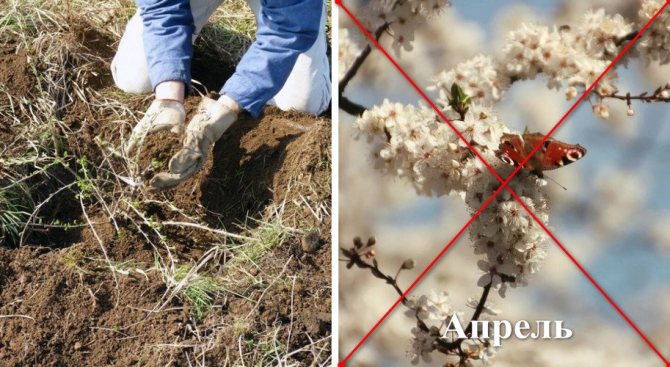

May
May is no less an inappropriate month. It will be best to postpone the transplant until September or next March. But if you are planning a move and do not want to part with your favorite variety, then it is important to carry out the process correctly.
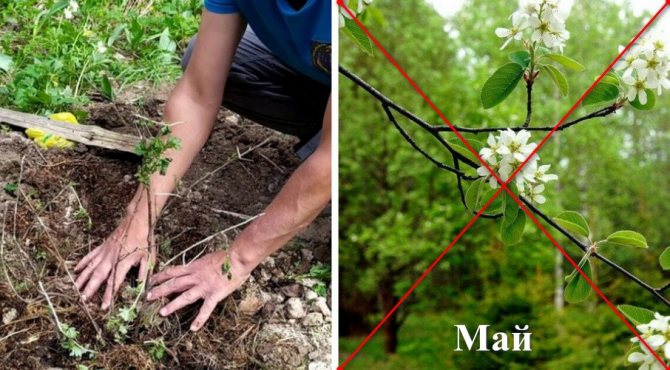

Required fertilizers
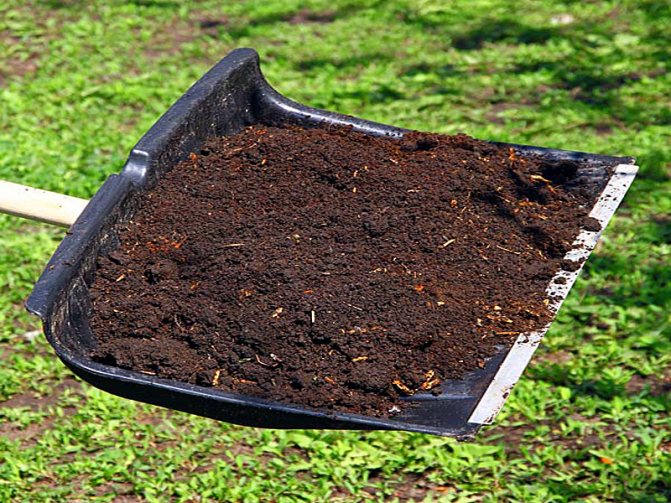

Soil compost
To ensure the guaranteed development of plant rhizomes and the subsequent fertile harvest, you need to constantly fertilize the soil. A fifteen-centimeter layer of ordinary earth is poured into the prepared hole. Fertilizers must be added to it. They can be superphosphate, wood ash, rotted compost or humus.
The mixture should have a uniform consistency. After overlaying these layers on top of each other, it is necessary to fill in the soil. Thus, the soil for planting will be ready. You can immerse a currant seedling or cutting in it.
Pruning young bushes
Planting red currants in the fall involves removing unnecessary branches during the same period of time. According to gardeners, pruning should be carried out 3-5 years after planting. The ideal time for clearing the bush from thickening is the end of October. Dry and infected branches are removed to the base. Young shoots are cut so that 2-3 strong buds remain on them. There should not be more than 2 young shoots on one base. A cut with a diameter of 8 mm or more must be lubricated with a special solution so that fungus does not form on the hemp.
Preliminary work
Before planting currants, it is very important to choose the best place and prepare the soil.
Seat selection
Currants grow well in areas with sufficient moisture content. If possible, it is planted on moist, even or with a gentle slope, well protected from the wind.
From directions should be preferred:
- northern;
- northwest;
- west side.
Excess moisture has a negative effect on currants. Therefore, low, swampy soils with a close occurrence of groundwater (closer to 1-1.5 m to the surface) are unsuitable for planting berry bushes.
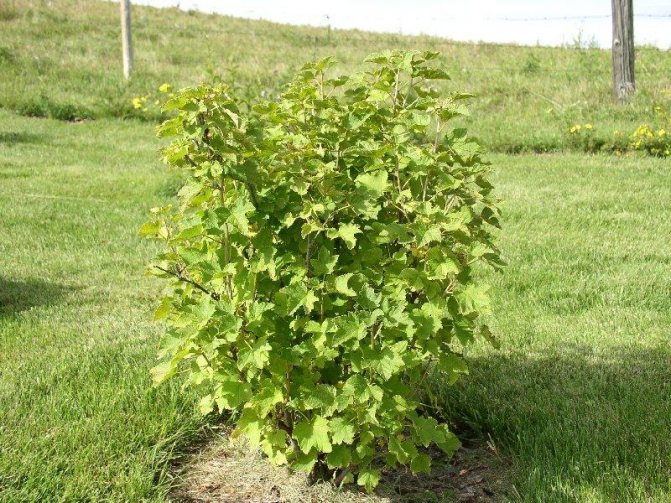

Favorable place for currant growth
In garden plots, currants can be planted after any types of vegetable or berry plants, except for related crops or crops with the same diseases:
- currants;
- gooseberry;
- raspberries.
Soil preparation
Fertile loamy soils with low or neutral acidity (pH 5-5.5) are best suited for growing currants. Soils with a high content of sand and salt, as well as marshy or rocky areas, are unsuitable.
The place chosen for the plantation is pre-leveled, plowed by 30-35 cm or carefully dug to the depth of the shovel blade. The roots of perennial grasses - wheatgrass, field bindweed, etc. - are carefully selected. The soil must be well cleared of these weeds, since it will be very difficult to remove them in the future, especially under mature bushes.
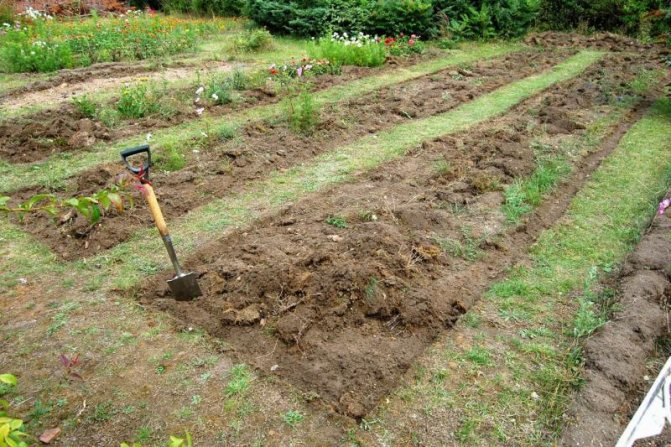

Soil preparation for planting currants
After the first digging or plowing, organic fertilizing is applied to the site:
- compost, humus, manure - 6-8 kg per sq. m;
- superphosphate (40-50 g);
- potash fertilizers (20-30 g).
Choosing a landing method
Depending on the variety and size of the bushes, their number, as well as the size of the planned place, one of the methods of planting currants in the spring is chosen.
Many berry varieties do not require cross-pollination with other species. But to improve fruiting and increase yields, it is permissible to grow two or three varieties in one area, alternating them with separate bushes or rows.
Single bushes
It is possible to plant currants in separate bushes if there are large free areas in the garden area. The method is used for growing and evaluating new varieties with high yields and taste, as well as for bushes with a large crown. With proper care, the productive period of plants is greatest. Planting is carried out at a distance of 1-1.5 m between the bushes. If several rows are planted, the aisles are made 1.5-2 m wide.
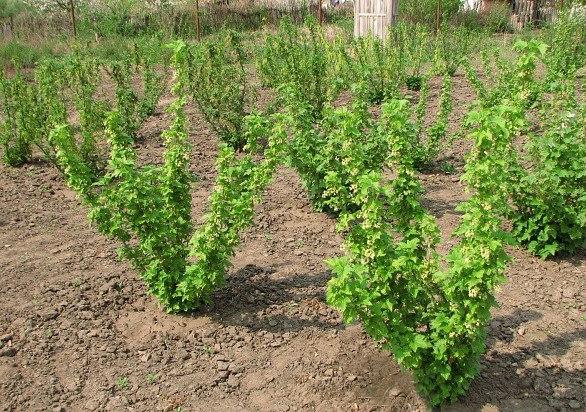

Placing currant bushes
In rows
This method differs from the bush method only in the reduced size of the intervals between plants in a row - 1-1.25 m. It is recommended for growing compact varieties with a small crown (Memory Michurin, Zagadka). Suitable for small areas.
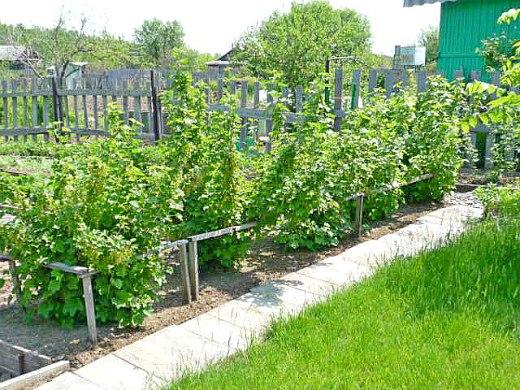

Placing currants in a row
Reasons for transplanting currants
The reasons for the transplant can be both planned and sudden, arising from a change in the environment. So, the rise of groundwater is an important factor that requires an immediate response. The roots will not be able to get nutrients from the soil because of the water, and the bush may die. The same force majeure will be the infection of a part of the plantation with viral diseases. In such a situation, healthy plants are transplanted to avoid contamination.
Video: Transplanting currants
A planned transplant is carried out in order to:
- rejuvenation of the bush;
- if you suspect a disease of the root system. In this case, the bush is dug up, examined, damaged roots are removed and planted in a new area;
- the size of the plant began to interfere with neighboring shrubs or beds;
- redevelopment of the site is being carried out.
Important! Fruiting of red currants occurs in the upper part of the shoots. Therefore, by shortening them when transplanting, you can only get a crop on the branches of new growth that appear on it.
Planting methods
There are various techniques that allow you to answer the question: "How to plant currants in the spring." It depends on the number of seedlings.
In this regard, the following methods are distinguished:
- Separate bushes... It is noteworthy that in this case it is necessary to leave a distance of at least 2 m between them. This method can be used to plant a new or especially valuable species.
- By creating rare rows... This is the most common method among gardeners. It is also one of the most compact, because the distance between the bushes in this case varies in the range from 0.5 to 1 m.After a few years, a continuous volumetric row of plantations will appear.
- By creating dense rows... In this case, the distance between plantings has a maximum of 0.5 m. This method is relevant for industrial planting.
The technique is selected taking into account the size of the site and the purpose of the landing. With the right approach, you can achieve maximum results and a fertile harvest. However, do not forget about the gentle care of plants and various measures to support its continuous development.
Carrying out the procedure in the spring in different regions
Currant is a plant that prefers the climate of the middle zone. For this reason, planting it in the spring in this region follows the algorithm indicated above.
In the north, the plant is planted according to the same rules, but the timing will be different. So, in the Urals and Siberia, spring comes late. The optimum temperature for planting is observed only in mid-May. For this reason, planting currants is carried out at this time, not earlier.Read about the best varieties for the Middle Lane.
In the south, the plant is planted early, as soon as a temperature of +100 is observed for several days. It is necessary to perform the procedure before the sweltering heat sets in, since in this case the plant may not take root due to a lack of moisture. After planting, it is recommended to irrigate the currants regularly. Only in this case will the plant take root normally. Watering is performed much more often than in the northern regions and in the central zone. However, currants should not be irrigated constantly. You can fill the plant, which will lead to rotting of the root system and the death of the bush.
Diseases and pests
In case of mistakes during planting and care, red currants can be attacked by diseases and harmful insects.
Most often, berry bushes have the following diseases:
| Name | Symptoms | Prevention and treatment |
| Anthracnose |
|
|
| White spot (septoria) |
|
|
| American powdery mildew (spheroteka) |
|
|
| Overgrowth ("witch's broom", terry) |
|
|
| Rust (goblet, columnar) |
|
|
| Gray rot |
|
|
Did you know? The name currant comes from the Old Russian word "currant". It means emit a strong odor. The plant is so named because of the strong aroma that comes from the leaves.
Pests dangerous for red currants:
| Name | Symptoms | Prevention and treatment |
| Gooseberry sawfly |
|
|
| Gallica |
|
|
| Glass-maker |
|
|
| Spider mite |
|
|
| Leaf gall aphid |
|
|
| Bud weevil |
|
|
| Gooseberry moth |
|
|
| Fire | eaten flowers and ovaries |
|
| Leaf roll |
|
|
What kind of frost can currant withstand?
Currant bushes are considered frost-resistant - it is not for nothing that fruit crops are successfully grown even in Siberia. In winter, plantings are able to calmly tolerate temperatures up to - 35–40 ° C in the presence of a shelter. And in the southern regions and the middle lane, the plant can not be covered at all if frosts are expected not lower than - 15 ° C.
As for return frosts, the culture buds survive in spring at temperatures down to -5 ° C. Blooming flowers will endure a cold snap to -3 ° C, and the ovary will remain on the branches at a temperature of -2 ° C.
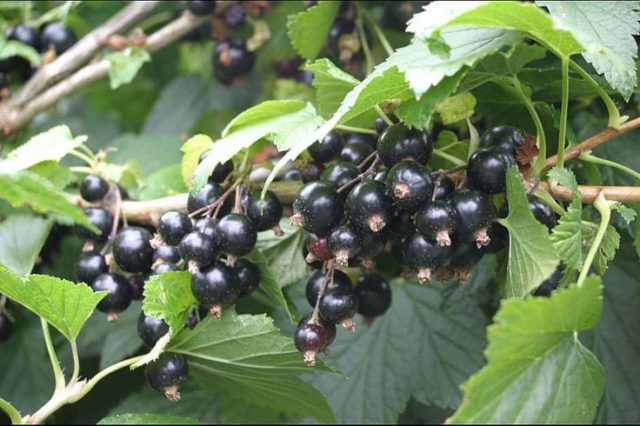

Watering and feeding
A well-developed, strong root system of red currants guarantees the plant good health and the ability to tolerate prolonged drought, however, a lack of liquid causes a growth retardation of the bush. If the acid is not enough water during the formation of the fruit, then the harvest will consist of small, sour berries, which can crumble even before they are fully ripe. To achieve good yields, the shrub must be provided with active watering in the first week of June and in late July - early August.
When watering, water is brought not under the root, but into an irrigation groove dug around the plant at a distance of 30-40 cm. About 25-30 liters of water are consumed for each square meter. When the liquid has been absorbed, it is advisable to loosen the soil shallowly to avoid the formation of a dry earth crust. If the near-trunk circles have been mulched with organic matter since spring, then the need for acid wood in watering and weeding is reduced.
Red currants need feeding for active fruiting and maintaining health. During the season, it is recommended to fertilize the bush 3 times:
- in April, after heavy rain or abundant watering, urea granules (10-15 g per square meter) are sealed under the bush;
- in mid-June, red currants are watered with a solution of manure (1:10) or poultry droppings (0.5: 10), you can replace organic matter with a complex of mineral fertilizers (for 10 liters of water, 20 g of superphosphate and 10 g of urea and potassium sulfate each);
- the final top dressing is carried out at the beginning of October, when digging near-trunk circles, rotted manure, matured compost or peat with the addition of superphosphate and potassium chloride are introduced.
Regionalized varieties
Natali red currant
Recommendations for the region of their planting, formed as a result of breeders' research, are called zoning... The following are the main regions of currant cultivation and varieties, suitable for cultivation in these regions:
- In conditions Moscow suburbs an excellent choice would be: Natalie, Dutch red, Dutch pink, Tsiralt, Versailles white, Red viksne, Sugar, Detvan, Beloved, Osipovskaya;
- Varieties suitable for planting in the middle lane: Erstling aus Vierlanden, Natalie, Dutch pink, Ziralt, Generous, Versailles white, Red viksne, Jonker van Tets, Detvan, Red Andreichenko, Dutch red, Vika, Niva;
- Varieties suitable for growing conditions in Siberia: Natalie, Yuterbogskaya, Dutch pink, Tsiralt, Sugar, Detvan, Krasnaya Andreichenko, Ural beauty, Ural souvenir, Dutch red, Obskoy sunset, Vika;
- Good varieties to grow in Ukraine: Natalie, Yuterbogskaya, Generous, Versailles white, Detvan, Vika, Niva.
Preventive treatments for diseases and insects
To protect currant bushes from diseases and damage by harmful insects, preventive treatments are required. Spraying is carried out according to step-by-step instructions in several stages:
- after the snow melts, the fallen leaves are removed from under the bushes, the top layer of the soil is loosened and treated with copper sulfate;
- at the time of budding, the plantings are sprayed with Bordeaux liquid with a concentration of 3%;
- during the ripening of the fruits and after picking the berries, a 1% Bordeaux mixture is used.
Organic and chemical preparations help to save plantings from pest infestation. Among natural remedies for processing currants, the following are common: soap solution, herbal preparations, infusion of tobacco, garlic or onion peels. If there are signs of insect damage on foliage and branches, it is advisable to use more powerful drugs, for example, a solution of colloidal sulfur, insecticides "Karbofos" and "Vofatox".
Rules and technology for planting fruit shrubs in the spring
When planting the varieties Selechenskaya and Pygmy, as for most others, certain rules should be followed. Only in this case can the plant take root and yield a good harvest in the future.
Rules for the selection of raw materials and material preparation
For planting currants, you need to choose good material. You can buy raw materials in a nursery or at a specialized point of sale. It is recommended to purchase planting material from a nursery that is located in the same region where the plant will be grown. You can also buy raw materials at a specialized point, which is located north of the currant planting site. Find out about the advantages and disadvantages of Dobrynya currants here.
The rules for the choice of material depend on its type.
Planting seedlings
When choosing a seedling, you should pay attention to the following points:
- Root system. It should be well developed. This is indicated by 3-5 main roots and several adventitious processes covered with a mesh. There should be no rot, damage and signs of activity of parasites and pathologies. It is not recommended to take seedlings with dry roots. Many sellers say that they just need to be moistened, but there is no guarantee that this procedure will help.
- Age of the currant. Professionals recommend purchasing seedlings 1-2 years old. It is believed that such a plant will take root better on the site.
- Aboveground part of the bush. It is best to buy raw materials with a couple of shoots. The minimum seedling height should be 15 cm.
- The presence of defects in the seedling. The currants should be free of damage and traces of the activity of parasites and pathology.
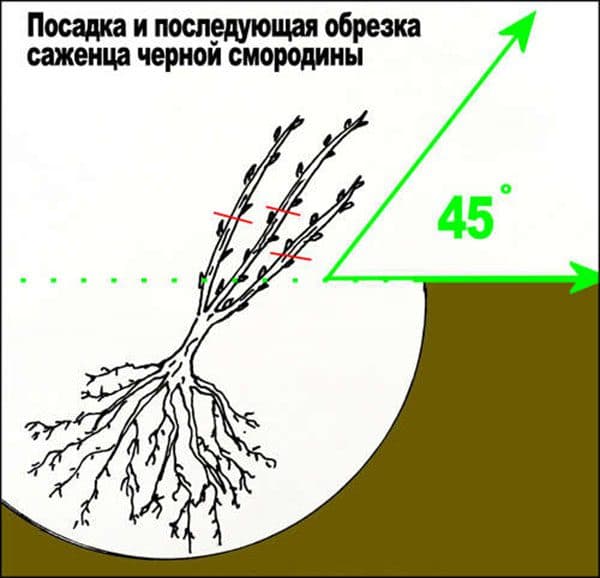

Cuttings
If you plan to plant not seedlings, but cuttings, then the raw material should be cut from currants, which are 1-2 years old. The size of the material is 20 cm, no more. The lower cut is made diagonally under the lower kidney. Titania will tell you about planting and caring for currants in this material.
Professionals advise giving preference to seedlings, since such material has a root system, so it will quickly take root and begin to grow. For cuttings, this process will take longer, since initially all the forces of the raw material will go to rooting.
How to choose a seat
For the plant to take root, it is important to choose the right planting site.To do this, you should adhere to the following recommendations:
- currant is a light-loving plant, therefore it is recommended to plant it on the sunny side of the site;
- it is not recommended to place the plant in a lowland, since water will stand here for a long time in the spring months, and it will be cool in the summer;
- plant the bush so that on one side the shrub has protection from the wind, the best option is at the fence, if you do not protect the plant from the wind, then strong gusts will break young shoots, which will lead to a lack of harvest for several years;
- check the depth of the water table, as the close location of the liquid to the roots will cause rotting, which will eventually lead to the death of the plant.
The soil
Currants root best and grow in slightly alkaline soil. In the event that the soil has high acidity, it is necessary to use a means that will lower it. The following products can do this:
- dolomite flour;
- slaked lime;
- crushed chalk;
- crushed chicken egg shells.
Pour the selected product into the well by one third. This will help neutralize the acidic soil environment.
Illumination
The fruit shrub loves light. For this reason, it is recommended to plant raw materials on the sunny side of the site. Shrubs should not be placed on the shaded side as this will adversely affect plant development and yield.
Neighborhood
It is not recommended to place currants with fruit trees and spreading berry bushes. This is due to the fact that the roots of these plants will draw out all the nutrients from the soil. As a result, the currants will not be able to take root. In addition, a shadow falls from the tall trees. As a result, the berry bush will have a lack of light, which will also prevent it from taking root and gaining growth. This link will tell you about the characteristics of the Dutch pink currant variety.
Another unwanted neighborhood is next to the gooseberry. This is due to the fact that both plants are subject to the same pathologies and parasite activity. For this reason, bushes are not recommended to be planted next to each other.
Planting pit preparation
Before planting currants in the open field, it is recommended to prepare a pit. This should be done according to certain rules.
Depth
This parameter of the hole depends on what kind of raw material is used for planting:
- the depth of the hole for seedlings is 40 cm, width is 50 cm;
- for cuttings - should be equal to the length of the bayonet shovel.
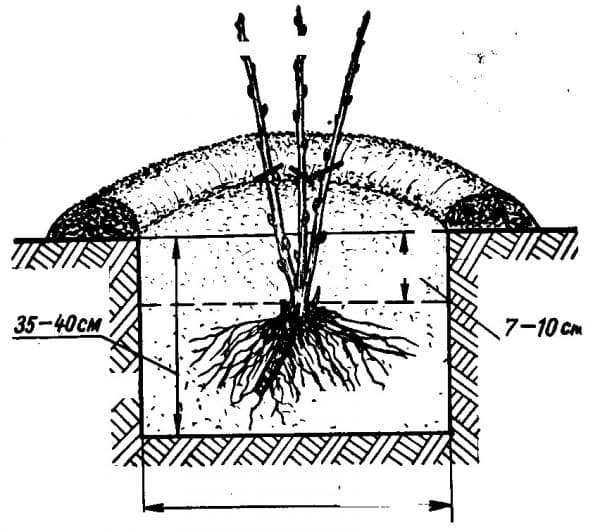

Depth and width of the planting pit.
Deepening is recommended to be done 12-15 days before the procedure. The top layer of earth, 15-20 cm thick, should be laid separately, since this soil will be used for feeding raw materials.
Soil fertilization
Fertilizing the soil is a mandatory procedure before planting currants. It allows the plant to take root and provides nutrients for growth. To feed the soil you will need:
- 15 liters of rotted manure;
- 200 gr. simple superphosphate;
- 120-140 gr. potassium sulfate.
Instead of the last two fertilizers, you can use wood ash in the amount of 2 kg. All components are mixed with the top layer of soil deposited after the formation of the hole.
It is impossible in the spring to introduce fresh manure and nitrogen-containing preparations into the soil for fertilization. In the first case, the root system will be burned, in the second, leaves will begin to form on the branches, which will draw nutrients from the roots, preventing the currants from taking root.
Placing planting material in the pit
The rules for planting and transplanting currants to a new place depends on the type of raw materials used.
Saplings
If the planting of currants is carried out by seedlings, it is recommended to examine the roots the day before the procedure. If they are dry, then the roots are cut by a third and soaked for 12 to 15 hours. The temperature of the liquid should be at room temperature. A pale pink potassium permanganate disinfectant solution can be used instead of water.It is also permissible to use a biostimulant solution. It could be Kornevin or Epin. The rules for preparation and use are indicated on the package.
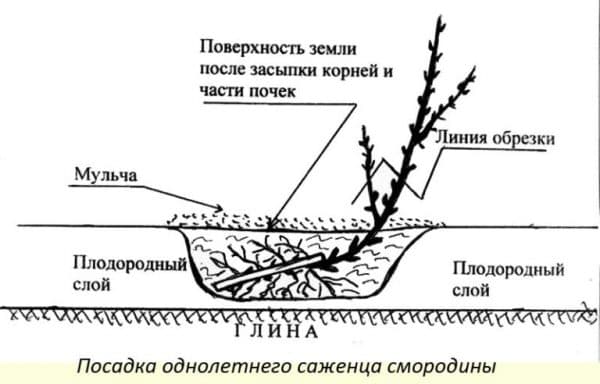

After soaking, the root system is immersed in the mixture, prepared clay silt in the form of dry powder and mullein. The products are mixed in such proportions to obtain a thick sour cream. The roots are immersed in the prepared mass and left to dry. The process takes several hours. To speed it up, it is recommended to leave the plant in the sun. After that, you can use the raw materials for planting.
Algorithm for planting seedlings:
- pour a bucket of water into the formed hole;
- install the raw materials in the hole at an angle of 450 to a depth of 10 cm;
- gently straighten the root system;
- fill the hole with soil without much tamping;
- irrigate;
- cover the soil with a layer of mulch - you can use peat chips, compost, humus.
Apply fertilizer after 2.5-3 weeks. It is best to use nitrogen-containing fertilizers in the amount of 15 grams. Top dressing can be applied dry or diluted in water and poured under the roots of the seedling. Nitrogenous fertilizers may be replaced by:
- urea;
- ammonium nitrate or sulfate.
It is also recommended to treat the plant to protect it from pathologies and parasites. To do this, you can use copper sulfate or Bordeaux mixture.
When carrying out the procedure, it is important to take good care of the root system. Any damage can lead to the plant not taking root. As a result, the seedling will die before the fall or will not be able to survive the winter.
Cuttings
Many gardeners prefer planting currants with cuttings. This is due to the fact that with proper cultivation of the material, the bush will bring a good harvest, and the fruits will have characteristics that are almost 100% identical to the characteristics of the parent bush.
This is especially important for experienced gardeners who have managed to grow a plant with large, sweet berries that yield a rich harvest. Thanks to the method of propagation by cuttings, an almost identical plant can be obtained. Find out about the currant variety Summer resident from this article.
It is also recommended to choose this planting method if only one currant bush is grown on the site, the quality of the fruits of which is completely satisfactory to the gardener. It is best to take the raw materials of a proven plant than to purchase goods from an unknown gardener or even in a nursery, since there is a high probability of buying low-quality material. Cuttings should be taken from branches, the thickness of which is from 0.6 cm.The raw material is cut so that the length of the material is at least 15 cm.
The day before the procedure, the cuttings are recommended to be placed in growth stimulants. To do this, you just need to use the following drugs:
- heteroauxin;
- indolylbutyric acid.
Currant cuttings are planted in holes or trenches. The latter method is preferable. It is recommended to form trenches in the fall and fertilize the soil. The raw materials are placed at a distance of 10-15 cm from each other.
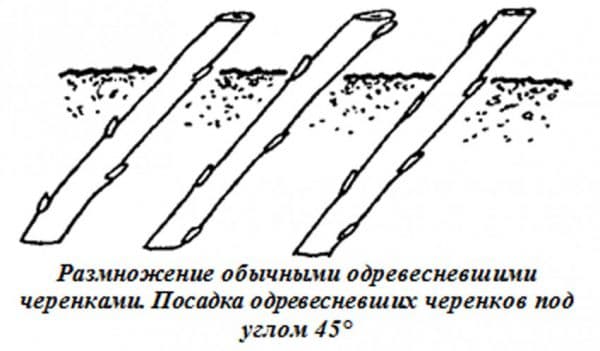

If you plan to plant in rows, the distance between them should be 40 cm. This distance should be done in order to make it more convenient to care for the plant. In addition, this allows you to normally dig up a rooted seedling in order to plant it in a permanent place of growth without damaging the root system of the plant itself or neighboring seedlings.
The stalk is immersed in the soil with its lower end to a depth of 3-4 cm. After that, irrigation and mulching are performed using humus or peat.
Watering
Watering Sibylla and Vologda, as well as other varieties, is carried out before planting the plant and after planting the currant. In the second case, irrigation should be performed according to the following rules:
- fill the hole with earth up to half and pour in water in the amount of 5-7 liters;
- fill in the remaining soil and pour in the next portion of liquid in the amount of 25-30 liters, but not into the plant itself, but into the furrows formed 20-25 cm from the seedling.
Distance between bushes
There are several landing methods:
- Single shrubs. This method is used to plant currants of a new variety or valuable species. The recommended distance between plants is 2 meters.
- In rows. In this way, bushes are most often planted in personal plots. The distance between the bushes should be from 0.5 to 1 m. After several years, the seedlings will grow and form a continuous row. This will happen in about 4 years. After that, it is recommended to rejuvenate the bush.
- Dense rows. This method is used for industrial planting of currants. Seedlings are placed at a distance of less than 0.5 m from each other.
What and when to fertilize
Recommended fertilizers for red currant bushes:
- potassium sulfate;
- furnace ash.
Note! With excessive application of lime fertilizers, there is a risk of chlorosis stains.
Mulching components (applied in a 13 cm layer after spring loosening):
- peat;
- manure;
- humus;
- compost.
Phosphorus-potassium dressing should be applied before the autumn digging. In the spring season and with the onset of summer, the soil is fertilized with nitrogen fertilizers.
With the onset of spring, approximately 22 grams of urea is added for each planting, in the flowering stage - cow or bird droppings. Spraying with one of the following formulations will help to increase the yield:
- boric acid essence;
- potassium permanganate;
- zinc sulfate;
- 2 grams of molybdenum-sour ammonium, diluted in a bucket of water.
Having harvested the crop, for laying fruit-bearing buds, it is recommended to fertilize the bush planting with one of the types of top dressing:
- 38 grams of superphosphate;
- 20 grams of potassium sulfate;
- 100 grams of ash diluted in 10 liters of water.
Note. Instead of mineral dressings for currant bushes, it is permissible to use organic matter at the rate of 2 liters per bush planting.
Competent arrangement of seedlings in the garden
When answering the question "how to plant currants in spring", you need to pay special attention to the competent choice of the planting location. It is important to remember that it is necessary to place seedlings only in an area that is fully illuminated by the sun.
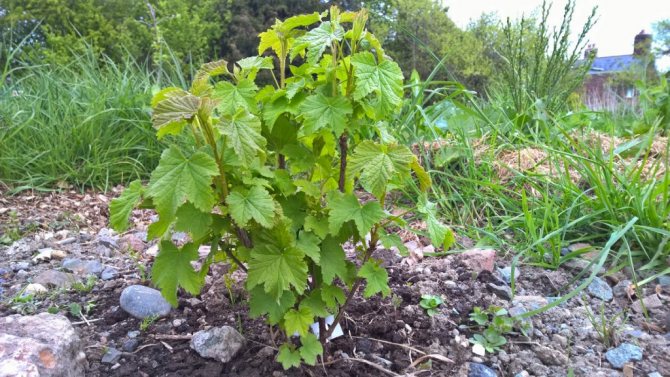

Young currant bush
It is preferable to choose the south side, because in this case the plant will be protected from drafts and strong winds, which can cause serious harm to it: the branches will break regularly, which means there will be obstacles to fruit emergence. He may be absent up to several years.
You also need to take into account that it is better to plant currants in that zone that is not very close to groundwater. Despite the fact that the plant loves abundant watering, such a location can negatively affect its roots: they will rot.
Care after landing
All newly planted blackcurrant seedlings need watering. Watering is necessary often until they take root, then watering is needed only if the earth is very dry. Especially do not forget to water in the heat, otherwise the growth of the bush will greatly slow down. Top dressing in the first year is not required, the plants will have enough of those substances that were introduced during soil preparation and planting.
Currants begin to bear fruit after planting in the 2nd year, and 4 summer bushes are at the peak of fruiting. For the winter, all plants must be covered with mulch, especially in the northern regions, the first pruning should be done.
The currant belongs to the category of special plant species, the most suitable time for planting which is autumn. At this time, the soil near the bush finally settles, which contributes to better ripening of the fruits. But if the summer resident, for one reason or another, is interested in planting it in spring, this option is also possible subject to certain conditions.
For everyone who wants to understand how the planting of currants in spring with seedlings is organized, we suggest that you carefully read the materials of this article.
Preparing for wintering, how to cover
Red currants are not afraid of severe frosts, but they do not tolerate spring frosts well. Therefore, for the winter it should be covered with agrofibre, which is removed in the spring after warm days are established. Before the winter period, the bushes must be bent, for example, pressed down with stones, digged in, wrapped with insulation. So they will be warmed by the earth and snow. They must first be cut off. The soil needs to be fertilized.
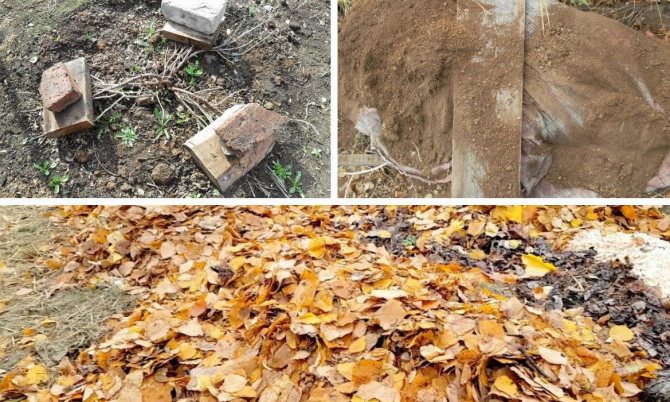

Gardeners reviews
★★★★★
Alla, 51 years old, teacher, Kemerovo. For the first time this year I decided to plant a red currant - I heard that it is not as demanding to care as black. Chosen variety "Victoria" and "Rondom". I will say right away that I am a beginner gardener, I did not know a lot of things, but nevertheless I collected a small crop and even was able to freeze some berries. She covered the bushes for the winter, so, I hope, next year, too, to harvest.
★★★★★
Sergey, 63 years old, pensioner, Krasnodar. Red currant is my favorite berry. Firstly, it is very easy to care for it, especially in our area, where there are no cold winters. I planted bushes of the Buzhansky variety 5 years ago, and I still consistently remove at least a bucket of berries from each plant every year.
Red currant is the choice of many novice gardeners, since this plant requires a minimum of effort and time, but at the same time allows you to harvest good yields. In order for the plant to bear fruit well, it is only important to properly prepare the place for planting and in the future do not forget to water and regularly feed the culture.
0

